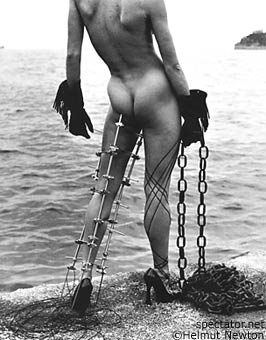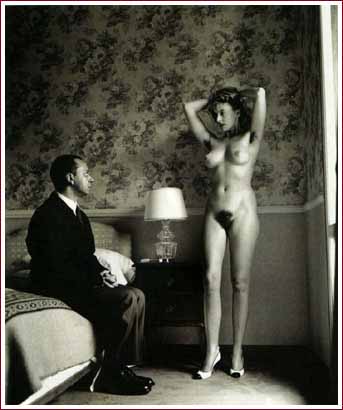January 30, 2004
Vision#3: turning away from the light?
Trevor,
In the light of the visual turn I've just taken as a recoil from the linguistic turn of both analytic and continental philosophy, I've been reading Bataille's various texts on vision or the eye.
A quick glance at these suggests that Bataille is undercutting the privileging of the eye and vision in philosophy (eg., Plato's turning away from false reflections towards the truth with his analogy of those who broke the chains of the cave and stepped out into the blinding light of the sun). For us, in Australia, the blinding light of the sun is the light of scientific reason that lightens up, and rolls back, the darkness of myth, superstition, prejudice and ignorance.
In the 'Solar Anus' text (reprinted in Visions of Excess) Bataille connects the sun with violent aggression rather than with Platonic illumination; and links the eye to the anus---or the lower and dirty part of the body. Bataille identifies with the sun and says that he is a filthy parody of the torrid and blinding sun.
In this reversal the solar anus is of the night (the darkness of Plato's cave.) I suggest that reversal can be read as part of the overturning of Platonism that was begun by Nietzsche.
I would suspect that the eye as sun also signifies the circularity of Hegel's dialectic: its stifling logic, rationalism and emphasis on categories or concepts.
previous next start
January 29, 2004
Feminism et cetera
Gary, here are several comments on your recent entries.
Yes, I have noticed that aesthetics is dismissed in Australian philosophy, in most analytic philosophy for that matter, as irrelevant. So-called ‘cognitive science’, the latest preoccupation of the analysts, reduces aesthetics to the physiology of perception, a matter that is not really relevant to aesthetics, as far as I can see. Oh well, if they weren’t irrelevant they wouldn’t put up with them in universities.
You write that the meaning and value of human life that was once a part of the religious and/or dogmatic metaphysics has now passed to the aesthetic. Shit! I don’t know. I’ll have to think about that. It seems to me true at least to a certain point but I’ll have to give some more thought and get back to you.
Yes, Newton and Hookesy both copped it in the last few days. And I guess neither of them got to experience the moment of death. What is it that Bataille wrote? The problem with death is that it only lasts for an instant. What is he pointing at here. I think he’s alluding to that point when the code of everyday signs (Klossowski) no longer has any meaning, when the social ceases to exist for the individual, when all the barriers in the way of the direct experience of reality are broken down. I’d like to think that this is what Goethe meant when he made Faust say ‘My greatest moment this! My whole life has been a preparation for it!’ but it’s not, although I think Goethe was aware of the zone that captivated Bataille.
Going on the photograph of the painting with Newton in the foreground, Courbet must have been an early feminist, or at least a representative of the female gaze. This is a pretty bald statement I know but if you look at female artists like Anaïs Nin or Catherine Breillat or Dominique Aury, they seem most interested in the genitalia, particularly but not exclusively in the female genitalia. From what I’ve seen, there are no cunts in Newton’s work, while in contrast, right from her first film, recently released on DVD as A Real Young Girl, Breillat has focused on the genitals. Breasts? There are some shots of them in the film but they are of minor concern. In both this film and 36 Fillette Breillat is interested in the young girl with the fuller figure but not out of any breast motive that I can discern.
I don’t go much for the feminist critique of Newton. It sounds like bullshit to me. ‘The female spectator can only lay claim to the gaze of the camera by becoming masculinized.’ What does this mean? Who lays claim to the gaze of the camera? We look at a photograph. Looking at a photograph is nothing like making a land claim. A female looks at the photograph and says that it was taken by a male, that it’s the view of a male, that it represents his desires. Okay. That’s true. Newton never pretended to be a woman or to present things from a female perspective.
But I don’t think he was a voyeur. Is Catherine Breillat a voyeur because she often focuses on genitalia? Of course she’s not. Let’s take her seriously. Calling Breillat a voyeur is just an excuse for not engaging with her. And why wouldn’t one want to engage with her? Because one doesn’t want to hear what she was saying. That’s how these feminists approach Newton. They’re prudes. They’re not standing up for women, as far as I can see. I think they are sexually repressive.
I agree that there are two Newtons, the fashion photographer and the artist. Perhaps there is a social commentator as well but I’m not really interested in him. I’m interested in the artist who expresses his phantasms. The more outraged, the more offended we are by his simulacra the better. As I said before, Newton is a Balthus with a camera. Like Bataille, he is giving voice to that part of reality we don’t like to talk about. Instead we scream ‘Voyeur! Voyeur!’
You say you couldn’t find the fashion images online where the woman gazes at a man's naked body as an object of desire. Perhaps not. I couldn’t find any such images in the fashion pages, but they are there in other more bawdy places. Remember The Full Monty. There seems to be a female gaze that is pretty much like the male gaze, if you ask me.
It always seemed to me that there was something deeply sexist in claiming that women and men see the world differently, that they are fundamentally different. And that is not what Nin and Breillat and Aury were doing. Their gaze, in as much as there is some historically specific female gaze, is surely a struggle with stereotypes (in the sense of Klossowski). Aren’t they saying something like, ‘What about the genitals? no one is talking about them. They’re kept out of sight’?
As you write, it is not difficult to imagine a lesbian artist appropriating Newton's photographic images to talk about the erotics of pleasure in looking and female visual desire. I agree that he had a Bataillean eye exploring the nexus where pleasure, pain, joy and anger.
Vision#2: the eye & slashing
It is interesting to read Bataille in the light of the previous post on visual culture. In an brief piece called 'Eye' (reprinted in Visions of Excess) he makes mention of the surrealist film by Salvador Dali and Luis Brunel.
The opening scene of this film----Andalusian Dog--- is one of a razor cutting the eye of a young woman:( it's actually a dead cow's eye)
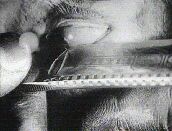
clip
Does that clip represents the violent termination of vision. Blindness? A rejection of the eye as a mirror of nature? A turn to the inner eye as inspired vision/revelation?
In his text Bataille mentions the eye of conscience, the eye of human justice and the eye of the police. These are juxtaposed or montaged-----in order to undercut the traditional privileging of vision in favour of a liberating blindness?
Bataille also wrote a pornographic book called Story of the Eye.
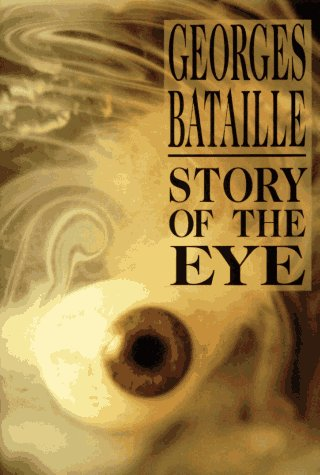 The illustrations were by Hans Bellmer, best known for his life-size pubescent dolls in sexually explicit positions.
The illustrations were by Hans Bellmer, best known for his life-size pubescent dolls in sexually explicit positions.
I have not read Bataille's book nor have I seen the illustrations done by Bellmer and Masson.
Sontag mentioned Bataille's Story of the Eye in the context of pornography elevated to literature in her essay The Pornographic Imagination, which was reprinted in Styles of Radical Will (1967). There she said "Experiences aren't pornographic only images and representations are." The book was eventually published as literary pornography in in english.
There is a brief account of the text here by Stefan Prince along with some of his paintings. Stefan says the:
"Story of the Eye relates the sexually charged adventures of three adolescents preoccupied with lewd acts and obsessive behaviour. At times soft boiled eggs, milk, a bull's testicles and an eye ball are employed during their sex games and when these games become ill-fated such elements mixed with lightning, rain, piss, gun shots and blood, take on a fantastic effect akin to a surreal roller coaster orgy of sex and death....
...The adventures of the narrator and his girlfriends Simone and Marcelle lead ultimately to Marcelle hanging herself (after they have rescued her from an asylum) and to the remaining pair teaming up for further adventures with an Englishman Sir Edmund. In Spain they witness the gory death of a bullfighter and sexually molest and murder a priest in his church vestry. Ultimately the three set sail from Gibraltar in a purchased yacht "towards new adventures with a crew of Negroes".
Stefan has a painting of that part of the "novella' in which the eye of a garrotted priest is shoved up the anus and vagina of the heroine.
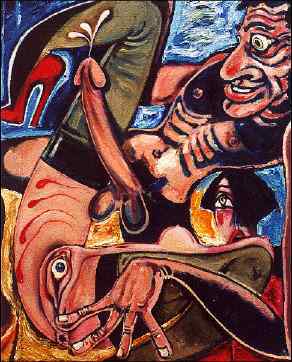 Stefan Prince, The Eye and he quotes a brief passge "in Simone's hairy vagina, I saw the wan blue eye of Marcelle, gazing at me..."
Stefan Prince, The Eye and he quotes a brief passge "in Simone's hairy vagina, I saw the wan blue eye of Marcelle, gazing at me..."
Is this a surrealist pissing or shitting eye?
It devalues the noble eye.
The eye is important in philosophy.
Sitting in the background as it were, sits old Hegel. First, we have Hegel's Master Slave dialectic of mutual recognition and affirmation. This world of intersubjectivity is one in which mutual regard embodies visuality; one situated within a range of sensory and embodied experience. Secondly, we have Hegel and Marx's idea of (the eye of?) reason being able to penetrate the appearances of processes to grasp the dialectical essences behind. Of couse the essential dialectical process---what makes something what it is----are only what appears.
Brunel's slashing razor that slits the eye is part of a surrealist tradition in which eyes are blinded, mutilated, or transfigured:
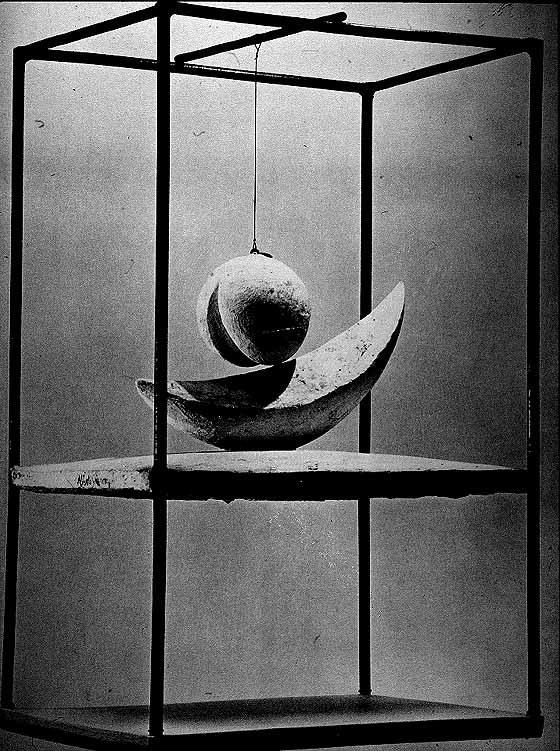
Albert Giacometti, Suspended Ball, 1930-31
What has happened since Bataille is the relentless suspicion of vision: that suspicion sees vision as a form of power, control and domination. What comes to mind here is Sartre's gaze, which robs the subject of freedom, & Foucault's Panoptican as an architectural embodiment of Sartre's absolute look.
January 26, 2004
Vision#1: Just an observation
Trevor, have you noticed that though the aesthetic is dismissed in Australian philosophy as irrelevant for philosophy, it was privileged in Continental philosophy?
I'm sure you have. We've experienced it.
The meaning and value of human life, which was once a part of the religious and/or dogmatic metaphysics, passed to the realm of the aesthetic? Continental philosophy from Schiller and Schelling to Adorno privileged the aesthetic.
Australian philosophy, in contrast, privileged scienceas the bearer of the Enlightenment. Aesthetics was seen as other to philosophy. Though it was acknowledged that professional (academic) philosophers) did aesthetics, aesthetics itself was something else than philosophy. So aesthetics could be ignored by the real philosophers.
And have you noticed how those who do aesthetics privilege literature or the literary at the expense of the visual arts? It is as if there is a denigration of the visual (ie., the image), or vision in aesthetic culture. Or that images are distrusted or regarded with suspicion. Or that looking is to be regarded with suspicion.
Have you come across this?
And yet our consumer culture is predominantly a visual culture. There is also the eye of power of the surveillance cameras in our public spaces and buildings.
And our computer screeens, when we are surfing the net, become an environment of constantly changing visual juxtapositions.
This digital world opens up possibilities of posing stimulating visual analogies, for being critical of those theorists who reduce the flux of visual surfaces to the stasis of linguistic method; and to treat the history of images in a fundamentally different manner than we are accustomed to from the practices of art history.
January 24, 2004
Helmut Newton: dead
Helmut Newton is dead. He was killed in a car crash in Hollywood today. The wire services report that he left the Chateau Marmont, lost control of his Cadillac limousine and ploughed into a wall nearby. The newspapers are publishing their obituaries.
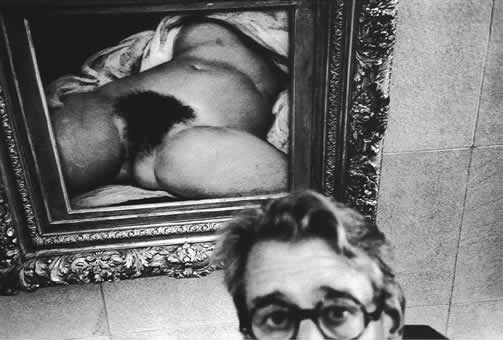
Helmut Newton, Me and Courbet 1996.
Newton mocked the fashion industry he was a part of. He understood that we are seduced by the fashion image rather than the product the image promotes. This transgression meant that he was more than a fashion photographer.
True, he was an old voyeur of women's bodies:
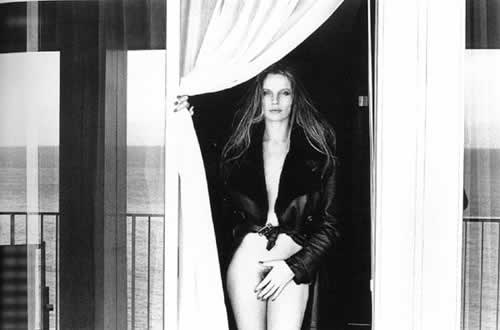
Veruschka, Nice, 1975
Hence the 1970's 'feminist criticism of Newton. This held that the female is an object of masculine desire whilst the female spectator can only lay claim to the gaze of the camera by becoming masculinized. Much of the feminist critical discourse over the next two decades ceded the erotic pleasures of looking to the male subject alone, constructing as masculine the very position of desiring access to the sexual image. From memory, this critical discourse used psychoanalysis as an account of the acquisition of sexual difference, and interpreted Freud to assert that female subjects are without access to the erotic pleasure of looking at sexual images. At best, women can have such access to the pleasures of looking at sexual images only through mimicking the spectator position of the male.
Newton undermined the objectifying masculine gaze than opens up a space for female sexuality in patriarchal culture:
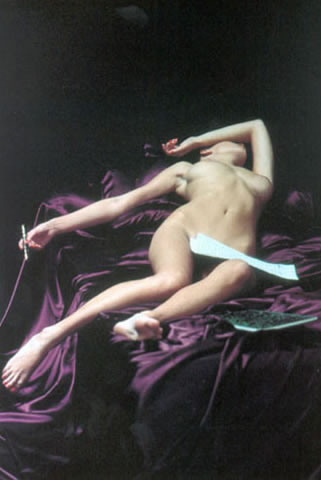
We move from a woman being an object of masculine desire to a self-determining subject with her own fantasies and desires to affirming her own sexuality in confrontation with the male gaze of the camera.
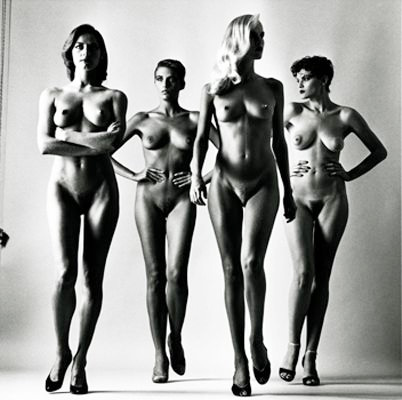
Sex and power redefined. I cannot find the fashion images online where the woman gazes at a man's naked body as an object of desire.
But it is not difficult to imagine a lesbian artist appropriating Newton's photographic images to talk about the erotics of pleasure in looking and female visual desire.
Newton did more than reflect the changing sexual power relationships that took place in the 1970s. He had a Bataillian eye that explored the nexus where pleasure, pain, joy and anger converge:
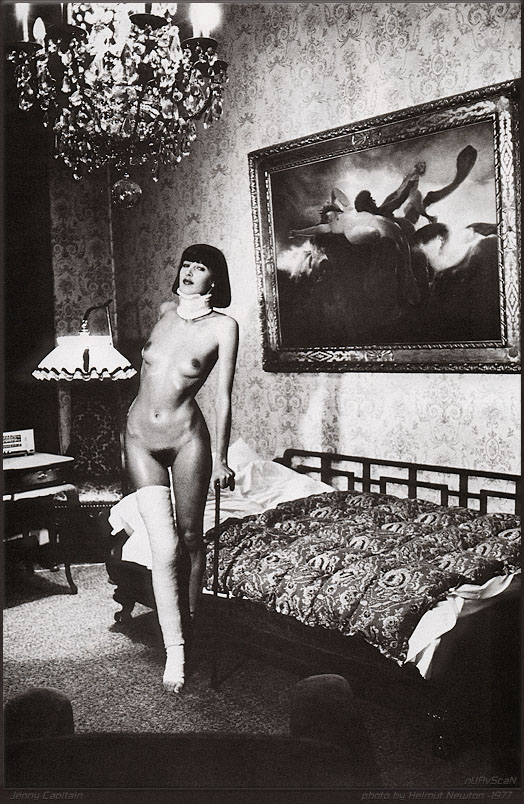
This intersects with a further feminist criticism of Newton that he depicts women bound and gagged or wearing leg irons.
What I'm calling Newton's Bataillian eye focuses on the taboo's of society and getting around them. Hence in the 1980s he adorned his models in neck, back and leg braces. The soft-hard contrast of smooth human flesh against the hard, sharp edges of the brace confuses the gazing spectator. What Newton plays with is our (men and women) response being a sexual one and we find corsetry both restrictive and sexual:
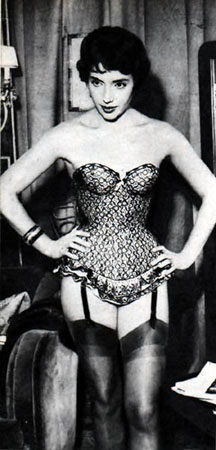
Newton highlights the similarity of bondage gear to orthopaedic appliances, even though orthopaedic bracing has a medical purpose whereas bondage is about restrictiveness leading to sexual pleasure.
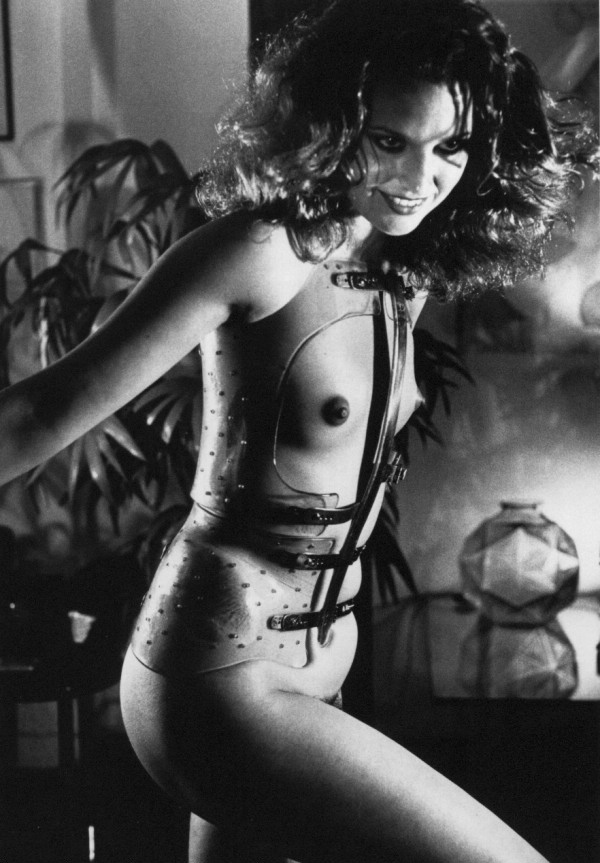
Helmut Newton, From Sleepless Nights, 1978
This recodes orthopaedic appliances as bondage gear.
There is a post on Helmut Newton as a fashion photographer over at Junk for Code
January 23, 2004
Bukowski and writing
Here is something on Bukowski, especially for Kristian and Hugo, but not only for them. I’ll begin with a remark about poetry.
“I never wrote poetry to read it but it sure got the rent. All the poets I had ever known, and I had known many of them, liked to give readings. I had always felt myself to be the recluse, the misfit, but my brother poets seemed to be very extrovert, very social. I didn’t like them. I avoided them.” (Shakespeare Never Did This, section 11 – there are no page numbers in this book.)
Why didn’t Bukowski like Hemingway?
“Well, he knew how to write but he didn’t know how to laugh.” (ibid, sect. 15)
I can’t help comparing this with Bataille:
“The disconcerting element in my style lies in the fact that its seriousness is not what it seems. The seriousness isn’t intentionally deceptive, but what could keep extreme seriousness from turning into laughter?” (On Nietzsche, p. 179)
In the Shakespeare book, Bukowski writes that he is not a intellectual, that he writes about all the gear the intellectuals have neglected, but don’t believe him. Very early in the book, he is dismissive when asked about Céline, but why mention him at all if he doesn’t want to draw his readers’ attention to the Frenchman? In the passage where he criticises Hemingway, he reports liking Céline and Knut Hamsun. He repeats all this again and again, in other books, in his letters, in his journalism, during interviews. So don’t let him kid you. When it comes to thinking about the literary tradition Bukowski was right up there at the cutting edge.
And why did he write?
“Well, it’s to give priests hard-ons.”
January 22, 2004
Bataille and Newton
Gary, the Newton image you posted of the two lovers in masks seems to me very Bataillean. Here is a passage written by Bataille’s friend and colleague, Michel Leiris:
“With full consciousness, love is reduced to a natural and bestial process – since the brain is symbolically suppressed by the mask – the fatality that forces us down is finally subdued. Thanks to the mask, in our hands this woman is in the end only nature itself, shaped by blind laws, without soul or personhood, a nature that this one time, at any rate, is completely chained to us… The gaze, the quintessence of human expression, is blocked out for a time – which lends the woman a still more hellish and subterranean significance. And the mouth, which can only be discerned thanks to a small split, is reduced to the animal-like role of a wound. The usual ordering of the decorative elements, finally, is stood entirely on its head; the body is naked and the head masked. These are all elements that make tools out of leather pieces … which correspond wonderfully to what eroticism actually is: a means of getting out of oneself, of tearing away the bonds which morality, reason and custom impose on us; simultaneously, a way of banishing the evil forces, of defying God and the terrestrial bounds of hell representing him, by taking over their property, the whole universe, in one of its particularly significant parts … and subjecting it to our control.”
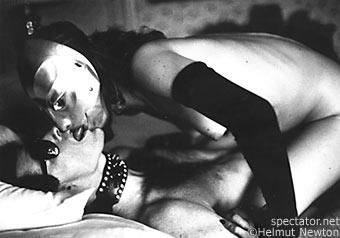
As you can see, while Leiris is not talking about Newton’s photograph, he might as well be. Newton’s mask finishes just above the mouth, into which the somewhat disguised male is extending hid tongue. The woman is on top – she is a predator, again reversing the usual roles. The clothing they are wearing, which is minimal, makes a fetish out of the scene, but this is not a fetish fostered as a part of our usual governmental pastoral care program. It strikes at the very heart of our social organisation. It is an example of what Foucault calls ‘transgression’. Perhaps part of the power, the shock-value, of Newton’s art stems from this.
January 19, 2004
philosophy conference
A philosophy conference is to be held at Adelaide University this year. Those organizing the conference are calling for expressions of interest in a conference entitled:
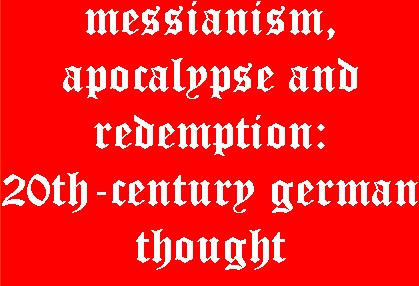
The organizers say that:
The conference will be held at the University of Adelaide, South Australia, from Monday July 19 to Thursday July 22 2004.
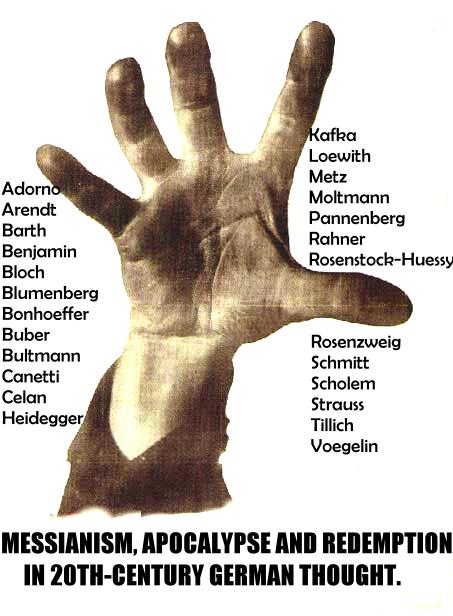 "We are interested in the persistent use of these essentially religious terms to express the hopes, forebodings and tasks of post-Nietzschean 20th century German thinkers. The widespread deployment of the images of apocalypse, redemption and messianism across different religious and secular faiths as well as different disciplines seems to have been indicative of the need felt by a large number of German thinkers to draw upon more archaic yet still vital speech to capture the moods and responses to the catastrophes of the first half of the 20th century."
"We are interested in the persistent use of these essentially religious terms to express the hopes, forebodings and tasks of post-Nietzschean 20th century German thinkers. The widespread deployment of the images of apocalypse, redemption and messianism across different religious and secular faiths as well as different disciplines seems to have been indicative of the need felt by a large number of German thinkers to draw upon more archaic yet still vital speech to capture the moods and responses to the catastrophes of the first half of the 20th century."
The organizers go on to say that:
"It is anticipated that selected papers will be published in a book of the same name. Each chapter in the book will be devoted to one major German thinker and how his or her thought is informed by and contributes to the problematic of messianism, apocalypse and/or redemption."
The organizers go on to say that they intend to inaugurate a journal along similar lines extending beyond Germany and relating it to twentieth century thought generally.
So if you know of any of your colleagues who may be interested in the conference could you please pass on this information. The organizers are:
Dr. Wayne Cristaudo
(wayne.cristaudo@adelaide.edu.au)
Dr. Engelhard Weigl
(engelhard.weigl@adelaide.edu.au)
Rev. Mike Pietsch
(pietsch.mike@sa.lca.org.au)
January 18, 2004
Bataille & Erotic#4: de Sade
In Eroticism Bataille makes an interesting remark about the Marquis de Sade. Bataille says de Sade maintained that:
"...Life...was the pursuit of pleasure and the degree of pleasure was in direct proportion to the destruction of life. In other words, life reached its highest intensity in a monstrous denial of its own principle." (p.180)
If so, then de Sade undermines the utilitarian enlightenment from within. He shows that the dark side of modern life is intrinsic to the pursuit of utility. He does this by disclosing how the utility ethos of the market is connected to the pleasure of violence. This is taken for granted in the market discourse with its notions of creative destruction, efficiency through cost-cutting and downsizing and competition. The pursuit of utility is intrinsically a violent one that is usually articulated in Social Darwinian terms of "only the best surviving", "the survival of the fittest" etc.
de Sade attacks bourgeois civilization with its own weapons.
January 17, 2004
Helmut Newton
Trevor, I have to admit that when I first encountered Newton many years ago I recoiled in shock, even though I was attracted by Newton's visual inventiveness. The book was White Women.
From memory, the images in that book used a variety of props and body positions for Newton
to depict beautiful women engaged in rough sexual trade:
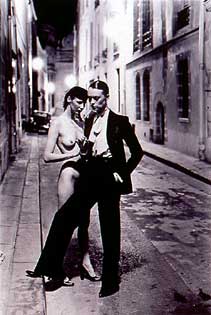 The settings were variously the Villa D'Este on Lake Como in northern Italy, in or around swimming pools on the French Riviera, powerful cars and limousines, public streets and in public places, and in hotel rooms and bedrooms.
The settings were variously the Villa D'Este on Lake Como in northern Italy, in or around swimming pools on the French Riviera, powerful cars and limousines, public streets and in public places, and in hotel rooms and bedrooms.
Now, many years latter, I read the images in White Women as an expose of decadent bourgeois life---fascist chic. He undermines the categories which separate commercial (fashion) from artistic photography.
As a fashion photographer in the sixties and seventies Newton took his models off the catwalk and made them the subjects of dramatic narratives. He went beyond the requirements of a commercial fashion shoot to represent women who desired whomever they liked, whenever they liked and in whatever way they liked:
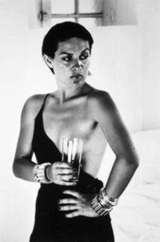
That female gaze saw bodies to have and use.
Some images by Helmut Newton to ponder.
And:
And:
January 15, 2004
In favour of fetishism
Gary, I read your latest contribution after I made my last entry, which is why I appeared to ignore what you had to say. Since then I’ve read what you said on fetishism, and while that might be okay as far as it goes, it’s not relevant to what I was talking about. That’s why I suggested that we forget about the social issues for a moment. I wanted to talk about the artistic effect on the viewing audience of works like Tanner’s and Newton’s. We’re talking about an effect that is akin to a shock effect. It may effect some people as revulsion. Talking about fetishes is just a way of changing the subject.
In any case, I’m not sure that Newton is portraying a fetish. This whole notion of fetishes presupposes a notion of normal sexual activity, or some such. But what’s normal? Imagine a roadworker standing in the bar. “Have another drink Fred?” “No, I promised the missus I’d be home early. We’re gonna do the business tonight.” Is this normal? It sounds a bit ritualistic. Fred is obviously not normal at all.
Quentin Crisp said that being healthy was having the same diseases as everybody else. Is being normal something like being healthy? Is the missionary position normal? Should we be naked or clothed? Is foreplay okay? If so, how much? Isn’t Newton depicting a kind of foreplay?
Perhaps a lot of us are kind of diminished human beings. We’d like to have good sex but somehow it has all become something of a routine. Perhaps we’re all a bit like Fred? And perhaps Newton is just reminding us of it.
Anyway, I reckon Newton is an artist. I think I can see a phantasm ticking away there in his work, even if I can’t say what it is.
Klossowski on art
Gary, seeing that our conversation is continually touching on the subject of modern art, I thought I might write something about Pierre Klossowski’s views on the topic. It’s a bit potted and if it offends someone enough to make them reply then well and good.
I’ve previously written about his ideas on the soul, its tonality & moods, which comprise an intensity without intention, and its phantasms. I’ll distinguish between a mood of the soul and a phantasm. If I am a melancholic it is not because of experiences I have had. If I happen to spend a lot of my life painting pictures of old houses, this is because of experiences I’ve had. It is relatively easy to see that I am a melancholic. It is not so easy to say what the pictures of old sheds signify. I am a melancholic by tonality and mood. I am also driven by some phantasm or other but it is impossible to say what. This is because all we have is the expression of my phantasm – the pictures of old sheds.
So what do we have? a melancholic mood, an instinctual obsession – for that is what a phantasm is – of unknown origin and meaning, and it’s expression, the paintings of old sheds. These paintings are what Klossowski calls ‘simulacra’ – the expression of some phantasm, an instinctual obsession.
Now we are in a position to say what artistic expression is. Artistic expression is the expression of some phantasm. According to Klossowski, artistic expression is without intersubjective meaning.
Nonetheless, works of art communicate. How is this? Well, according to Klossowski, simulacra become detached from the phantasm of which they are the expression and they enter the code of everyday signs. In other words, simulacra take on a communicative function and become part of language, in this case of a visual language. When they come to take on strong communicative significance Klossowski calls these detached simulacra ‘stereotypes’.
Here is a good example of a stereotype. In Panofsky’s book Perspective As Symbolic Form, he describes how Renaissance battle signs differ from earlier feudal depictions. The hand extended towards the viewer by a soldier shot through the eye by an arrow, or the shaft of the arrow, which is thicker at one end than the other, does not describe things better as they are but represents a powerful symbol of the new perspective, and thus a means of teaching the new view. A work of art takes on communicative meaning because it gives expression to phantasms through the manipulation of established stereotypes.
Seen in this light, modern art can be given a precise meaning. With modernism art became critical. Modern art is critical art (this, incidentally, is why the post-modernists are so anti-critical – it’s not just political comformism). Modern art is art that is self-conscious of itself. For the first time, art recognised the constraints of its symbolic heritage and it threw them over. In order to do this it aimed to forsake expression. A good example is the work of Braque and Picasso in the hermetic period, when they goal was to make their paintings indistinguishable, to suppress all evidence of a phantasm. It was an impossible endeavour. The consequence was a new, broader, more comprehensive set of aesthetic standards, and with that new stereotypes began to emerge. This is why, as Adorno wrote, painting a la cubist now is like making advertising posters.
January 14, 2004
Fetishism
Trevor, the two images mentioned previously remind me of fetishism. Or more accurately, fantasies of fetishism.
The usual understanding of ‘fetishes’ is connected to Freud's discourse of sexuality. Freud used the term to represent sexual "perversion". Fetishism allows the fetishist to derive sexual pleasure where normative sexual intercourse does not.
The other meaning of fetishism is in Marx's economic discourse of capitalism where it is linked to the aura of ‘commodity fetishism’. This fetishism Marx argued was central to the commodity or consumer culture of industrial capitalism.
The two images previously mentioned are of a woman as a fetished sexual object in a patriarchial culture who is available for men to buy for their pleasure. The two senses of fetishism have come together.
In these two senses fetishism is everywhere in our culture today. There are many types of fetishism, and these coexist and function in different ways. If we use Foucault's terminology highlights the way some of these practices of fetishes are both potentially productive in escaping or subverting the normative/conventional ways of sexually relating, and facilitate the construction of new subjectivities.
An example would be the practitioners of S&M and the ritualized practices of contemporary dungeon slaves their mistresses as athe dominatrix figure, such as Domina Lady MacLaine. So we have
femdom.cartoons
January 13, 2004
Bukowski: Poem#11
Melancholia
the history of melancholia
includes all of us.
me, I writhe in dirty sheets
while staring at blue walls
and nothing.
I have gotten so used to melancholia
that
I greet it like an old
friend.
I will now do 15 minutes of grieving
for the lost redhead,
I tell the gods.
I do it and feel quite bad
quite sad,
then I rise
CLEANSED
even though nothing
is solved.
that's what I get for kicking
religion in the ass.
I should have kicked the redhead
in the ass
where her brains and her bread and
butter are
at ...
but, no, I've felt sad
about everything:
the lost redhead was just another
smash in a lifelong
loss ...
I listen to drums on the radio now
and grin.
there is something wrong with me
besides
melancholia.
January 11, 2004
On Not Feeling Like It
Gary, what you said about labouring and philosophy failing to readily synthesize made me think of the early days when I was training to be a teacher. While at college it was impossible not to be a radical and alternative student with a critical disposition a moral determination but whenever I was out on teaching practice in a school the theoretical stuff seemed to lose all significance. I remember that I was trying to read The Positivist Dispute In German Sociology, which at the time was quite beyond me, but anyway when I was away from a school I didn’t have any trouble concentrating on the game. In the staff room I’d get the book out and try to read it. It could get passed my eyes but somehow it didn’t get into my head. They were just sentences whirling around. It was hard yakka. (For Kristian, Hugo, et al, this is an Australian word based on an Aboriginal name for grass trees. For ‘yakka’ use the word ‘work’. I won’t try to explain how this comes about.) Later I was told by my superiors that I didn’t mix enough in the staff room and so I put the book away. I wanted to be good. I wanted to get through.
Even now I have friends and acquaintances I mix with at uni and they seem quite normal to me. It’s only when I bring any of them home or in any way try to mix them with my other friends that I realize how strange and out of place they are in my world. I guess this means that I’m schizophrenic. That’s okay. If health consists in having the same diseases as everybody else then I must be healthy. The point is, the intellectual stuff requires a certain environment. Fuck! This blog wouldn’t exist if we weren’t both hermits – urban and suburban hermits, that is.
I agree that Nietzsche provided Foucault and the French poststructuralists with the means to transcend Hegel and Marx. Here is where Bataille is different. He wasn’t thinking about things in that way. He didn’t want to transcend anyone. He wanted to give voice to all the stuff that’s there all the time but never mentioned, or at any rate not treated seriously. When I say that it wasn’t treated seriously, I mean it wasn’t treated seriously by the guys who think, basically the chappies who want to transcend Hegel and Marx.
I think Adorno and Bataille are close. Indeed, I think that Adorno tried to capture as philosophy that which led Bataille beyond philosophy. This may be Australian craziness, I know, but I don’t give a fuck. As soon as you all out there start seeing Adorno and Bataille as essentially on the same plane, you’ll start to get some theory that you can take with you anywhere. Sure, when you’re buggered from painting all day you might not feel like seven this sort of theory, but one evening you will. You get over being buggered when you have to work every day.
On abstract expressionism, I think that its debt to surrealism was largely formal or technical. As your previous illustrations have amply shown, Gary, some surrealist paintings look a bit like abstract expressionist paintings. But surrealism isn’t really about technique or mode of expression. Surrealism isn’t like cubism. It isn’t another modernist mode of painting. While it has its literary and painterly expressions it’s not really an artist position at all. The essence of surrealism is found in that concern of Bataille’s that I have already mentioned in connection with Adorno. Surrealism wants to bring to expression everything that our culture wants to sit on top of, wants to keep down and suppress. How it achieves this aim is irrelevant just as long as it achieves it. In the end this achievement isn’t a great feat. What is suppressed forces itself to the surface. You just have to get out your surf board and ride it in.
As you say, the stuff by Dorothy Tanning is nothing like abstract expressionism. Hey! It’s more like Helmut Newton than Jackson Pollack, don’t you reckon? I’ve put the together so that you can see for yourself.
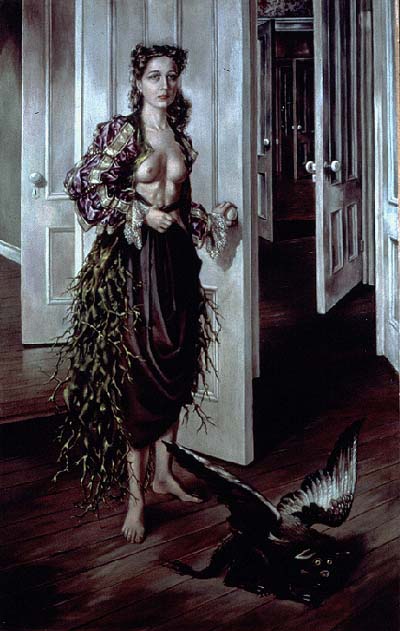
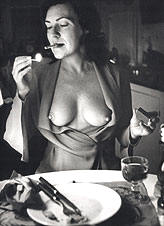
Of course, one is a male vision and one female, but if we put aside their differences, what do the two works have in common?
January 10, 2004
Bukowski: Poem: #10
Love
she's young, she said,
but look at me,
I have pretty ankles,
and look at my wrists, I have pretty
wrists
o my god,
I thought it was all working,
and now it's her again,
every time she phones you go crazy,
you told me it was over
you told me it was finished,
listen, I've loved long enough to become a
good woman,
why do you need a bad woman?
you need to be tortured, don't you?
you think life is rotten if somebody treats you
rotten it all fits,
doesn't it?
tell me, is that it? do you want to be treated like a
piece of shit?
and my son, my son was going to meet you.
I told my son
and I dropped all my lovers.
I stood up in a cafe and screamed
I'M IN LOVE,
and now you've made a fool of me ...
I'm sorry, I said, I'm really sorry.
hold me, she said, will you please hold me?
I've never been in one of these things before, I said,
these triangles ...
she got up and lit a cigarette, she was trembling all
over. she paced up and down, wild and crazy. she had
a small body. her arms were thin, very thin, and when
she screamed and started beating me I held her
wrists and then I got it through the eyes: hatred,
centuries deep and true. I was wrong and graceless and
sick. all the things I had learned had been wasted.
there was no living creature as foul as I
and all my poems were
false.
Charles Bukowski
January 09, 2004
eroticism and pornography
Hey, Gary, it was good to receive an e-mail from Kristian and Hugo, who are out there somewhere reading this stuff. Bukowski is their particular interest. I’ve only had a glance at their stuff but they seem to be interested in poetry and through poetry Bukowski. I’ve been thinking about what I might write in response to their e-mail. In due course I’ll write something.
In the meantime, I’ve been thinking about our perennial topic of surrealism and pornography. You’ve been writing some interesting things about the female experience, which of course is also the film-maker Catherine Breillat’s enduring concern.
What stuck me is a slightly different matter. You recently posted a couple of digital images of Helmut Newton photographs. They got me thinking about Newton.
Newton’s images are meant to be art, photographic art. Who’d doubt it. They look okay next to Balthus’ paintings. In fact, Balthus and Newton have something in common. In fact, they have many things in common. Their topic is sex. That need not be shocking in itself but the art of Balthus and Newton is unsettling. Their object is the female body.
Perhaps, here we’re close to that issue concerning you – the female sexual experience. It will always be inaccessible to males, I’m afraid. The perspectives of Balthus and Newton are necessarily male perspectives of the female body, although if I may say so there is something explicit or self-conscious – even critical – in Newton’s male perspective. His art can even be seen as social commentary, but I wouldn’t advise it – it only serves to minimise the shock effect. Let yourself get stirred sexually by them if that is your want. As much as any genuine work of art communicates anything, the arousal of sexual desires is surely the intention of Newton’s work.
I know some of it is stylised and even fictionalised, and could be illustrations for Carter Brown or Ian Fleming – this is another thing Newton has in common with Balthus. In any case, stylisation serves sexual arousal. Newton even has a red Indian princess in bikini and war bonnet – now that’s style!
On the question of the unsettling effect of Newton’s photography, consider the following image:

There’s not too much of the female body shown here – you could say the minimum for the maximum effect. It is modest in comparison with most pornographic images readily available on the Web. Indeed, neither Newton nor Balthus are interested in the depiction of the vagina. The vagina is much more Catherine Breillat’s domain, i.e., the woman’s domain.
Newton’s is a very male image. You could see it as a male fantasy but isn’t that exactly what Newton intends? Isn’t this the unsettling part of his art? Isn’t it the depiction of male fantasy not to feed an appetite (or even to induce one) but to unsettle the male viewer that Newton is after?
When I look at Balthus I see Bataille, and when I look at Newton I also see Bataille. Am I deluded?
While on this topic of looking like Bataille, consider the following section from Bukowski’s poem, ‘snake eyes’ (What Matters Most Is How Well You Walk Through The Fire):
Am I just speaking to myself
and this is the medium through
which I speak.
still, if somebody reads
this
and your day and your
night
were
akin to mine,
then somehow we’ve touched,
strange brother or
sister,
and we both understand that death is
not the
tragedy.
Under every bush lurks Bataille – if you have the right kind of Gnostic vision. (I got my glasses from Health Partners)
January 08, 2004
too tired for philosophy
I've been too tired to read Bataille, surf the web for the surrealist insights into sexuality, engage with the poststructuralist response to Bataille, or research pornography and de Sade.
I've been cleaning and painting the electronic cottage to get it ready rent it, and I've been collapsing at night from the fumes. I'm just a tradesman these days.
I've taken Bataille's On Nietzsche with each day this week,so as to start reading part 2 at lunchtime. But I cannot concentrate on the text. It's all too difficult. By lunchtime I just want to sit out the front of the inner city cottage, eat my packed lunch, watch what is happening on the street, monitor my inner experience whilst drinking a coffe and then take the standard poodles for a quick walk to the parklands. Labouring and philosophy don't synthesis easily.
I cannot even think philosophically whilst I'm painting. All I've been able to do is come up to a realization that Nietzsche provided Foucault (and nearly all French poststructuralists) with the impetus, ideas and pathways to transcend Hegelian and Marxist philosophies. Personally I don't understand the need to transcend Hegelian Marxism given the creative way Adorno made use of this tradition, but I recognize that Nietzsche is a sign of rupture for the French.
January 06, 2004
Bukowski: Poems#9
Heart
during my worst times
on the park benches
in the jails
or living with
whores
I always had this certain
contentment-
I wouldn't call it
happiness-
it was more of an inner
balance
that settled for
whatever was occurring
and it helped in the
factories
and when relationships
went wrong
with the
girls.
it helped
through the
wars and the
hangovers
the back alley fights
the
hospitals.
to awaken in a cheap room
in a strange city and
pull up the shade-
this was the craziest kind of
contentment
and to walk across the floor
to an old dresser with a
cracked mirror-
see myself, ugly,
grinning at it all.
what matters most is
how well you
walk through the
fire.
Charles Bukowski
January 05, 2004
On On Nietzsche
Gary, your sustained attempt to get on top of On Nietzsche is commendable. Interpreting this book is one of the great feats of scholarship. Many just give up. Keith Ansell Pearson’s review of Klossowski’s book on Nietzsche is a good example. Pearson much prefers Klossowski’s book to Bataille’s. He says of Klossowski’s book that ‘It has a certain communion with Bataille’s writings, including his own text of Nietzsche, but on account of its trenchant insights, exacting rigor, and exquisite precision, it goes way beyond anything one encounters in Bataille’s book on Nietzsche… Where Bataille’s attempt to make Nietzsche impossible and unusable can often read like a series of unconvincing postures and poorly conceived riddles, in Klossowski’s text these aspects of Nietzsche are pursued with an absolute rigor and a sustained logic of disablement.’
I’ve read both these books so let me say what I feel. Despite the extremeness of its interpretation and the uniqueness of its style, Klossowski’s book is readily meaningful to academics because it proceeds in the established way. I’ve discussed this before. Like Pearson, the standard response is, ‘Wow! That puts Nietzsche in a different light.’ When you get through On Nietzsche you don’t know what to think.
What does this say? Bataille’s book is not a study of Nietzsche. If we approach it as a diary or a journal we might get closer to understanding what it is that we are reading. It was written during the war, when normal activities of society were in abeyance. And in any case, Bataille wasn’t an academic. He was a librarian who had been invalided out.
I think it would be wrong to regard it as a journal, all the same. A standard journal shows the progress of one’s thought. I’ve written a journal for several years – you’ve seen it, as have others. No reader of a real journal expects some unity of vision, a coherent thesis or a developed narrative. We don’t even expect consistency. Today I might think this, tomorrow something else. That’s the way it goes. That’s the stuff of diaries and journals.
On Nietzsche is different. It says, ‘here it is, to the best I can say it.’ It’s complete, even if it doesn’t satisfy its author and he returns to write more on the same topic. In fact, the book is part of a trilogy. It’s known as Summa Atheologica. Why? What does it suggest? The other volumes, Inner Experience and Guilty, are written in much the same way. The fact that they are a trilogy suggests some sort of completeness. What is atheology? Why does it need to be talked about in this way? Why can’t it be more like Klossowski’s book? These are the questions.
January 04, 2004
surrealism & sexuality#4
Maybe I was looking in the wrong for the surrealist expressions of sexuality and the displacement of our experienced reality of sexuality as part of their rebellion against a bourgeois culture and desire to tranform that mode of life.
The 1940's American abstract expressionist covered over, or repudiate, their debts to the European surrealists:
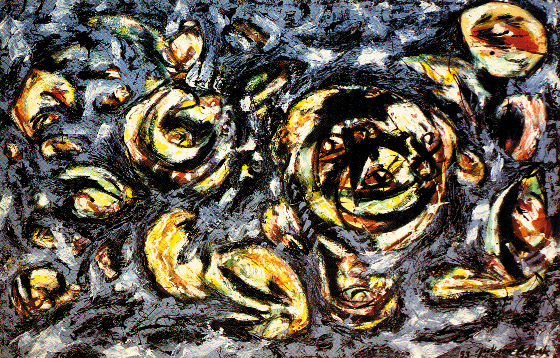
Jackson Pollock, Ocean Greyness, 1953.
They--the New York School, as they are known in the art history books--- celebrated the depth of their revival and continuation of European abstraction instead.
The US is now seen as the centre of things, European surrealism is viewed as a dead end and formalist art criticism becomes hegemonic. On the formalist writing of art history (eg., Alfred Barr and Clement Greenberg) the Abstract Expressionists had evolved an "American" type painting that eschewed politics and celebrated modernity.
Let us retrace out steps back to the surrealists.
Consider this full length self-portrait of Dorothy Tanning at the age of thirty, bare breasted, standing in front of an endless succession of open doors, with a succubus crawling at her feet:

Dorothy Tanning, Birthday, 1942.
A succubus is not just a fantastic, furry creature: it is a female demon fabled to have sexual intercourse with sleeping men.
Does that image call into call into question the normality of human sexual experiences by dissolving our myths?
It introduces the female experience of sexuality as distinct from the male one. As this surrealist exhibition at the Tate makes clear:
"The portrayal of women as muses was a familiar surrealist theme. Believing that women had a closer connection to the desired irrationality of dreams than men, they pictured them as alluring sorceresses, child-women, and quasi-magical beings.....This way of presenting women was intended to elevate rather than diminish the female sex, but ran the risk of seeming to cast women as a passive foil to male creativity, without a voice of their own. "
An example is Max Ernst's painting, The Robbing of the Bride (1940), in which a female figure is transformed into an alluring, bird-like creature:
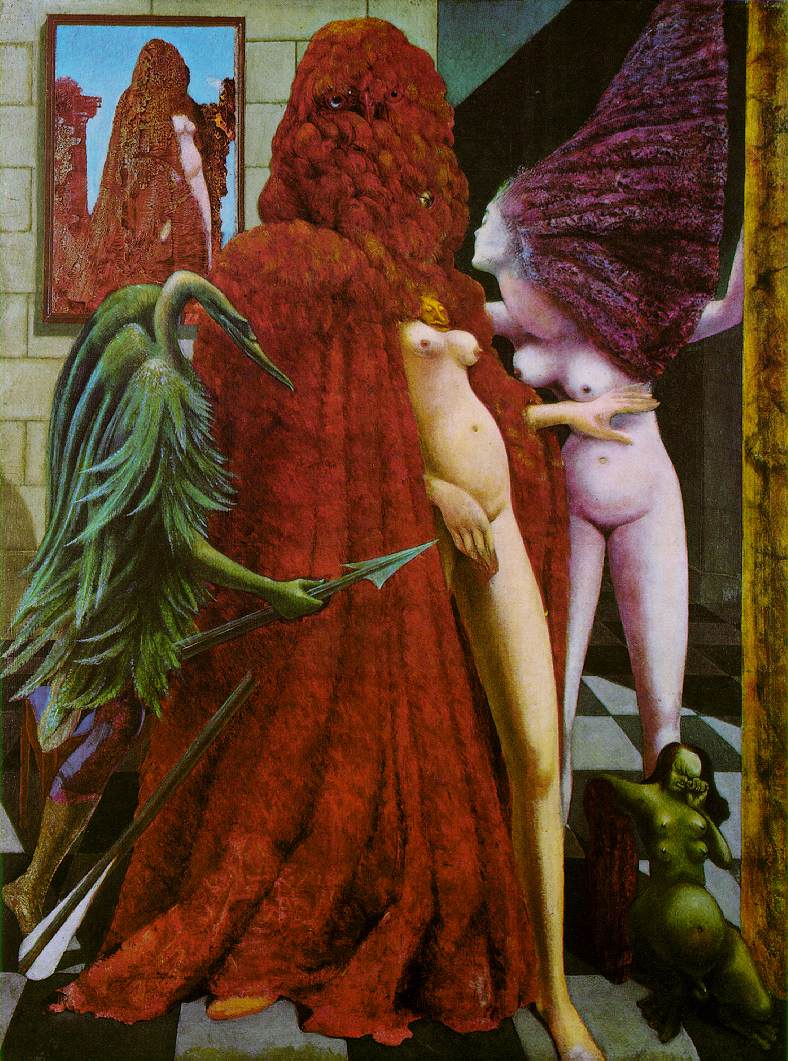
In Dorothy Tanning's self-portrait there is unease with being an enchantress.
January 03, 2004
surrealism & sexuality#3
I'm continuing my probing of surrealism and sexuality without much success. Weren't they supposed to be obssesed with desire unbound and sexuality? Consider this quotation:
"Adding greatly to Surrealism's scandalous appeal was the fact that, for the first time in an artistic movement, sex was give centre stage. Freud had already flagged-up the fact that sexual instincts and their sublimation lay at the core of the individual and of civilisation as a whole, but never had human sexuality in all its multifarious and often darkly perverse forms been so comprehensively celebrated as by the Surrealists.The word desire runs like a silver thread through the poetry and writings of the Surrealist group in all its phases," says Jennifer Mundy, curator of the Tate Modern's Surrealism: Desire Unbound which has Surrealism's obsession with our multifarious erotic urges as its central theme."
I'm staying with the Armenian-American painter Arshile Gorky for the moment because his late work was concerned with unlocking a network of symbols in which to recast the triumphs and tragedies of his own troubled life. It appears a good space to explore.
These paintings were a kind of diary that can be read as a commenting on his life.
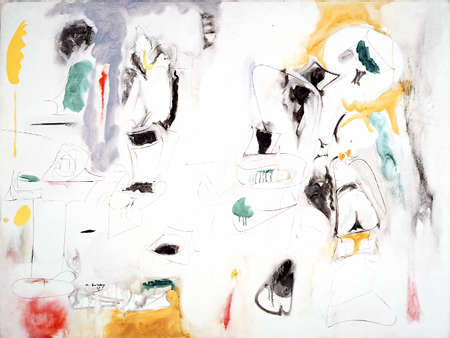
Arshile Gorky, Agony, 1947
What interests me here is the visual metaphors of felt new experience; or more accurately, the creation of new forms through a reworking of the old forms of the visual tradition. That reworking by the avant garde comes through an understanding of the tradition from which it is both a departure and a continuation.
My interest is less trying to understand what the surrealists were reacting against than the content they expressed in the new forms.
With Gorky we do have the remembrance of things past, as with this image:
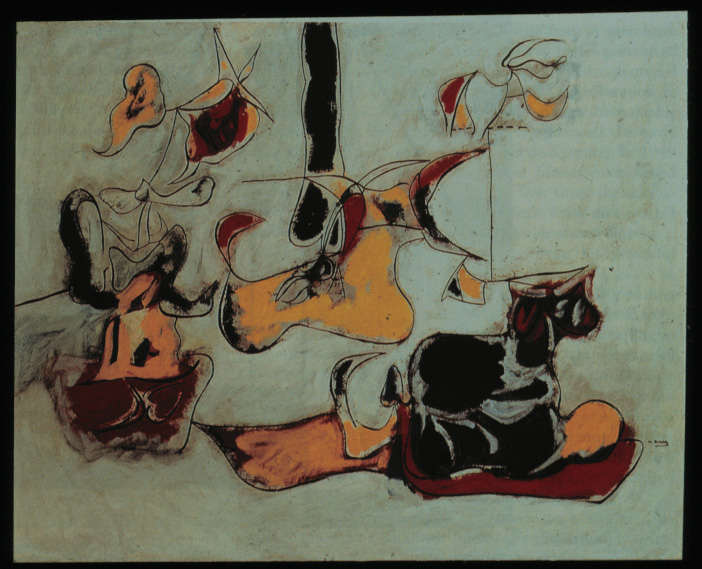
Arshile Gorky, Garden in Sochi, 1943
But I'm not having much luck with the new forms for the expressions of the new experiences of sexuality.
The above work, Garden in Sochi, was produced when the surrealists were in exile in the US during WW 2: it is a confluence of the American and European avant garde.

Arshile Gorky, One Year the Milkwood, 1944
It is close to the automatism of surrealism with its rapid drawing and loose brushwork that encouraged the spilling and dripping of the liquid paint. It also overlaps, or rather points to the drip style of the abstract expressionism of a Jackson Pollock. Gorky can probably be see as a key forerunner of abstract expressionism.
After the war the surrealist emigres packed their bags and returned to Paris to heroically regain their position as the cutting edge of the avant garde when existentialist was the intellectual fashion.
That leaves us with Gorky. In his One Year the Milkwood there is no expression of unconscious sexuality. The above painting is fuull of nice autumn colours and thus refers to the fertility of nature.
Maybe I'm looking in the wrong space. Maybe Gorky wasn't really a Surrealist.
Maybe the surrealist's erotic drawings were published in small editions and often anonymously to avoid censorship and prosecution?
January 02, 2004
On Nietzsche#7
The fifth and last chapter in Part One of Bataille's On Nietzsche is very short. It consists of a paragraph from Daniel Halevy's 1911 biography of Nietzsche. I quote it in full because of its old fashioned conception of Nietzsche.
Halvey says that:
"Nietzsche had always wanted to write a classical work, a history book, a system, a poem, something worthy of the old Hellenes he chose as masters. He never had been able to give form to that ambition. A the end of 1883, he had just completed an almost desperate undertaking; and the abundance and importance of these notes allows is to have some sense about the greatness of a work that remained utterly in vain. He could not provide his moral ideas with any foundation, nor could be write his tragic poem; as the two books were frustrated, his hopes disappeared. What was he? An unfortunate---capable only of short efforts, lyric songs, cries."
What a lot of nonsense!
At the end of 1883 Nietzsche had completed Bk 1 of Thus Spake Zarathustra.
He then went on to complete Bk's 2 & 3 of that text the following year; then wrote Beyond Good and Evil and Bk. 5 of The Gay Science in 1886; wrote The Genealogy of Morals in 1887; wrote The Wagner Case, Twilight of the Idols, The Antichrist, and Ecce Homo in 1888 before he collapsed in 1889.
Contrary to Halvey's claim, Nietzsche's most creative and productive period of writing lay before him in 1883.
Bataille would have to be writing against the Halvery's biographic conception, as he was largely working off The Will to Power in the first section of On Nietzsche. This was first assembled in 1901 from Nietzsche's Notebooks from 1883-1888, translated in 1910 and appropriated by the Nazi's in the 1930s. Bataille discredits their interpretation (ie., that of Alfred Baumler who said it was Nietzsche's final system and crowning achievement) but he does not discredit The Will to Power. He reads specific sectoins of it carefully.
But what text--edition/translation--- was Bataille reading?
I have no idea of what sort of edition of The Will to Power Bataille was working from. He has not mentioned it so far. It certainly is not the one we have now. We are probably reading quite different texts. Not that it matters. There is a tremendous diversity of Nietzsches with every distinct reading provides another Nietzsche. Nietzsche's texts both promote and facilitate such a fecund reception through the literary strategies employed. So what we do is read and position ourselves in relation to Nietzsche.
That ends Part One of On Nietzsche.
January 01, 2004
On Nietzsche:#6
Chapter 4 of Part One of Bataille's On Nietzsche consists of a series of quotes from Nietzsche's Will to Power. This is not unexpected since Part One is about Mr. Nietzsche, Batailles' companion, who speaks directly to his heart.
In this chapter the concerns are best expressed by par. 990, Bk 4 in The Will to Power. (Only Bk 1 & 3 are online). In this paragraph Nietzsche says:
"I forgot to say that such philosophers [Nietzsche's new sovereign philosopher] are cheerful and that they like to sit in the abyss below a perfectrly clear sky: they need different means from other men for enduring life; for they suffer differently (namely, as much from the profundity of their contempt for man as from their love for man).---The most suffering animal on earth invented for itself ---laughter."
Such philosophers, who teach estrangement in every sense, are still strangers to one another. They are homelesss, live as hermits and put on masks. They live alone and suffer the tormets of all seven solitudes. (para 989).
Bataille's series of quotes in Chapter 4 of his On Nietzsche start by referring to the gay, cheerful sovereign spirit who have taken refugee in happines being heavily protected and fortfied against attack. This light heartedness is necessary for those who sit by the abyss, whose hell and darkness are to near and who knows something that we dread. It is a mask; a mocking one that loves necessity and unlearns fear.
What is displaced in these quotes is Nietzsche's idea of sovereignty as the noble one, the great legislator, the sage. This is new type of philosopher who teaches eternal recurrence, overcomes everything Christian, uses his philosophical hammer to ensure that the old modes of thought perish, and endures eternal recurrence though the revaluation of all values.
What Bataille longs for is community. It is the big lack when you are homeless and suffer the seven solitudes.
